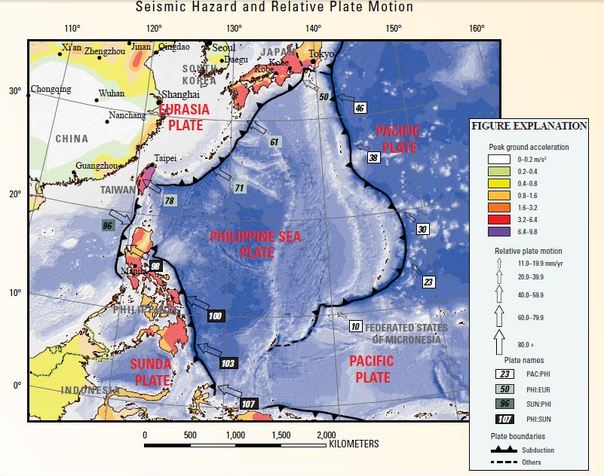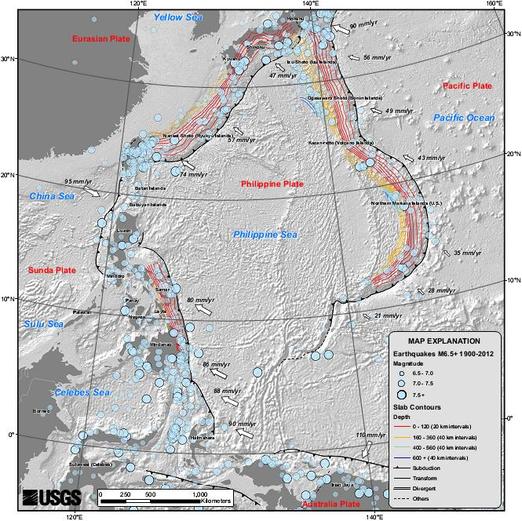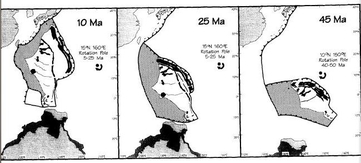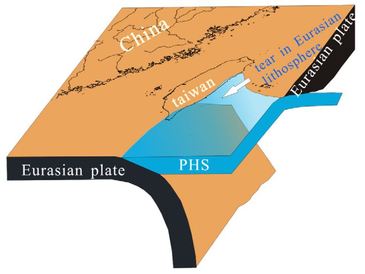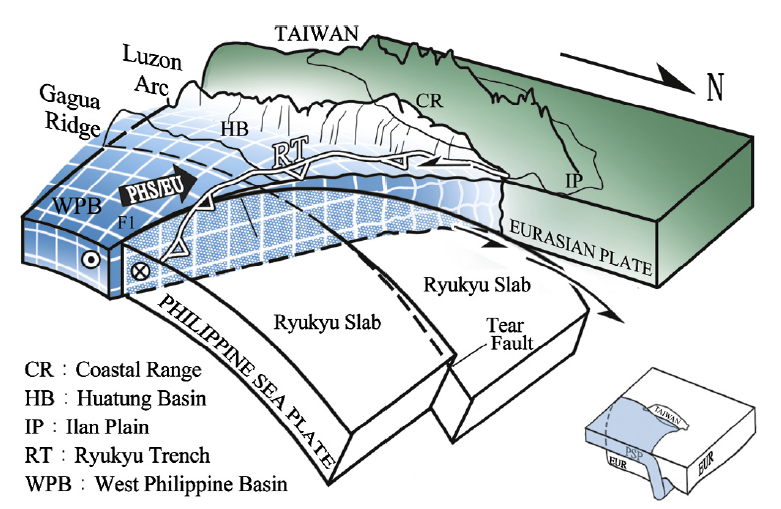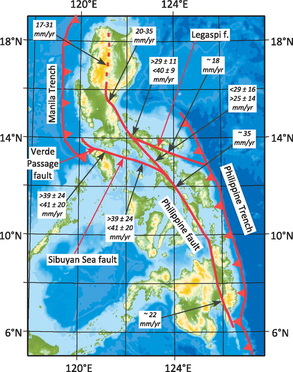The Philippine Sea Plate
The Philippine Sea plate is tectonically
unusual in that almost all the boundaries are convergent. The Pacific plate is
subducting beneath the Philippine Sea plate to the east while the
west/northwestern part of the Philippine Sea plate is subducting beneath the
continental Eurasian plate. There are shorter boundaries of the Philippine Sea
plate with the Okhtosk plate to the north, and the Australian plate to the
south. The relative plate motions and boundaries are all clearly depicted in Figure 1. Transform faults are also found near Taiwan and the Philippine
trench. The relative plate motion of the Philippine
Sea plate is ~80mm/yr relative to the Eurasian plate (Smoczyk et al., 2013) and is actively in motion today increasing the likelihood of earthquakes and tsunamis to occur in the near future. The plate thickness
varies throughout the plate where Yoshioka and Ito (2001) calculated values between
29-41km around the Nankai trough. They suggest variations in the thickness are
dependent on the age of the sea floor and the process of formation.
The areas surrounding the Philippine Sea plate are very active, producing numerous local earthquakes, tsunamis, and volcanic activity. In the 20th and 21st centuries, earthquakes of M 8.0 or greater, while M 7.0 or less are even more frequent (Figure 2, USGS Smoczyk, 2013).
The areas surrounding the Philippine Sea plate are very active, producing numerous local earthquakes, tsunamis, and volcanic activity. In the 20th and 21st centuries, earthquakes of M 8.0 or greater, while M 7.0 or less are even more frequent (Figure 2, USGS Smoczyk, 2013).
The evolution of the Philippine Sea plate originated lower than the equator about 55Ma ago and was followed by several tectonic events resulting in its present day location. Ultimately it was a change in the movement, to a westward motion, of the Pacific plate that converted the N-S transform fault on the Philippine Sea plate to the subduction zone currently present along the boundary between these two plates (Fang et al., 2011).
|
Studies have shown that the Philippine Sea plate has undergone multiple rotation events in its history, as evidenced from paleomagnetic data (Figure 3; Hall et al., 1995). They suggested that the Philippine Sea plate underwent a clockwise rotation of 50 degrees 40-50 Ma, followed by a period of no rotation until 25 Ma when another 40 degree clockwise rotation began, initiating the left-lateral Sorong Fault due to the collision of the Australian plate with the Philippine Sea plate (Hall et al., 1995).
|
|
|
In the northern region of the Philippine Sea plate, part of the Eurasian plate is being subducted beneath the Philippine Sea plate (Figure 4). This is surprising because the Eurasian plate is mostly continental crust, which is typically more buoyant than oceanic crust. However, the subduction is enabled by the South China sea floor, at the southern edge of the Eurasian plate, being more dense and moving at a faster rate than the Philippine Sea plate (Wang et al., 2009). This drags the Eurasian plate underneath the Philippine Sea plate, creating a unique subduction zone suggesting the presence of a tear in the northern region of the Philippine Sea plate. The variations in stress along the boundary may be linked to the growth of this tear which can be seen in Figure 5 (Lin et al., 2013). However, to the east of this, around northern Taiwan, the Philippine Sea plate is subducting beneath the Eurasian plate making this region considerably the most active collisional orogen in the world for ocean-continent interactions. Large earthquakes (Mw8.1) have occurred along the Nankai trench in 1944 and 1946 as well as several others due to the subduction of the Philippine Sea plate along its boundaries (Smoczyk et al., 2013).
|
A tear in the Eurasian plate due to the movement of the Philippine Sea plate creates a path for the upwelling of the asthenosphere along the northeastern region (Zheng et al, 2013). This is evidence of a slab window, which is a gap in the tectonic plate allowing the asthenopheric mantle to upwell in the specific location permitting more magmatism and higher heat flows (Cole et al., 2006). This phenomenon also occurs along the southern margin of Alaska, and at the collision of the Chile trench with the Chile ridge (Cole et al., 2006).
|
Along the western side of the
Philippine Sea plate lies the Philippine fault; a mega-fault caused by the
oblique convergence between the Philippine Sea plate and the Sunda plate (part
of the larger Eurasian plate). The fault extends for 1200km from the NW
corner of Luzon down to the SE end of Mindanao (Figure 6; Yu et al. 2013).
This left-lateral strike-slip fault has a long-term slip rate of 24-40mm/yr,
but is currently fully locked.
This poses dangerous threats to areas along the fault because it is unknown
as to when the fault will slip and produce devastating consequences due to
the highly populated areas of Luzon and Mandnao of 48.5 million and 21.58 million
people respectively.
|
Along the eastern side of the plate, the rate at which the Pacific plate subducts beneath the Philippine Sea plate ranges from 10 to 46mm/yr (USGS, Smoczyk et al. 2013). By examining the vertical profiles from the following USGS report, it can be noted that the Pacific plate is subducting beneath the Philippine Sea plate to great depths and at a very steep angle. This configuration produces several volcanoes and earthquakes along the boundary margin.
References
Byrne, T., & DiTullio, L. (1992). Evidence for Changing Plate Motions in Southwest Japan and Reconstructions of the Philippine Sea Plate. Island Arc, 1(1), 148-165.
Cole, R. B., Nelson, S. W., Layer, P. W., & Oswald, P. J. (2006). Eocene Volcanism Above a Depleted Mantle Slab Window in Southern Alaska. Geological Society of America Bulletin, 118(1-2), 140-158.
Hall, R., Ali, J. R., Anderson, C. D., & Baker, S. J. (1995). Origin and Motion History of the Philippine Sea Plate. Tectonophysics, 251(1–4), 229-250.
Hasegawa, A., Nakajima, J., Yanada, T., Uchida, N., Okada, T., Zhao, D. Umino, N. (2013). Complex Slab Structure and Arc Magmatism beneath the Japanese Islands. Journal of Asian Earth Sciences, 78(0), 277-290.
Huang, Z., Zhao, D., Hasegawa, A., Umino, N., Park, J., & Kang, I. (2013). Aseismic Deep Subduction of the Philippine Sea Plate and Slab Window. Journal of Asian Earth Sciences, 75(0), 82-94.
Iidaka, T., Iwasaki, T., Takeda, T., Moriya, T., Kumakawa, I., Kurashimo, E., Aoki, G. (2003). Configuration of Subducting Philippine Sea Plate and Crustal Structure in the Central Japan Region. Geophysical Research Letters, 30(5), - 1219.
Lin, J., Hsu, S., Sibuet, J., Lee, C., & Liang, C. (2013). Plate Tearing in the Northwestern Corner of the Subducting Philippine Sea Plate. Journal of Asian Earth Sciences, 70–71(0), 1-7.
Smoczyk, Gregory M.; Hayes, Gavin; Hamburger, Michael W.; Benz, Harley M.; Villasenor, Antonio; Furlong, Kevin P. (2013). Seismicity of the Earth 1900-2012 Philippine Sea plate and vicinity. USGS Open-File Report: 2010-1083-M
Ohkura, T. (2000). Structure of the Upper Part of the Philippine Sea Plate Estimated by Later Phases of Upper Mantle Earthquakes in and Around Shikoku, Japan. Tectonophysics, 321(1), 17-36.
Wang, Z., Fukao, Y., Zhao, D., Kodaira, S., Mishra, O. P., & Yamada, A. (2009). Structural Heterogeneities in the Crust and Upper Mantle Beneath Taiwan. Tectonophysics, 476(3–4), 460-477.
Yoshioka, S., & Ito, Y. (2001). Lateral Variations of Effective Elastic Thickness of the Subducting Philippine Sea Plate Along the Nankai Trough. Earth Planets and Space, 53(4), 261-274.
Yu, S., Hsu, Y., Bacolcol, T., Yang, C., Tsai, Y., & Solidum, R. (2013). Present-Day Crustal Deformation Along the Philippine Fault in Luzon, Philippines. Journal of Asian Earth Sciences, 65(0), 64-74.
Zheng, H., Gao, R., Li, T., Li, Q., & He, R. (2013). Collisional Tectonics Between the Eurasian and Philippine Sea Plates from Tomography Evidences in Southeast China. Tectonophysics, 606(0), 14-23.
Cole, R. B., Nelson, S. W., Layer, P. W., & Oswald, P. J. (2006). Eocene Volcanism Above a Depleted Mantle Slab Window in Southern Alaska. Geological Society of America Bulletin, 118(1-2), 140-158.
Hall, R., Ali, J. R., Anderson, C. D., & Baker, S. J. (1995). Origin and Motion History of the Philippine Sea Plate. Tectonophysics, 251(1–4), 229-250.
Hasegawa, A., Nakajima, J., Yanada, T., Uchida, N., Okada, T., Zhao, D. Umino, N. (2013). Complex Slab Structure and Arc Magmatism beneath the Japanese Islands. Journal of Asian Earth Sciences, 78(0), 277-290.
Huang, Z., Zhao, D., Hasegawa, A., Umino, N., Park, J., & Kang, I. (2013). Aseismic Deep Subduction of the Philippine Sea Plate and Slab Window. Journal of Asian Earth Sciences, 75(0), 82-94.
Iidaka, T., Iwasaki, T., Takeda, T., Moriya, T., Kumakawa, I., Kurashimo, E., Aoki, G. (2003). Configuration of Subducting Philippine Sea Plate and Crustal Structure in the Central Japan Region. Geophysical Research Letters, 30(5), - 1219.
Lin, J., Hsu, S., Sibuet, J., Lee, C., & Liang, C. (2013). Plate Tearing in the Northwestern Corner of the Subducting Philippine Sea Plate. Journal of Asian Earth Sciences, 70–71(0), 1-7.
Smoczyk, Gregory M.; Hayes, Gavin; Hamburger, Michael W.; Benz, Harley M.; Villasenor, Antonio; Furlong, Kevin P. (2013). Seismicity of the Earth 1900-2012 Philippine Sea plate and vicinity. USGS Open-File Report: 2010-1083-M
Ohkura, T. (2000). Structure of the Upper Part of the Philippine Sea Plate Estimated by Later Phases of Upper Mantle Earthquakes in and Around Shikoku, Japan. Tectonophysics, 321(1), 17-36.
Wang, Z., Fukao, Y., Zhao, D., Kodaira, S., Mishra, O. P., & Yamada, A. (2009). Structural Heterogeneities in the Crust and Upper Mantle Beneath Taiwan. Tectonophysics, 476(3–4), 460-477.
Yoshioka, S., & Ito, Y. (2001). Lateral Variations of Effective Elastic Thickness of the Subducting Philippine Sea Plate Along the Nankai Trough. Earth Planets and Space, 53(4), 261-274.
Yu, S., Hsu, Y., Bacolcol, T., Yang, C., Tsai, Y., & Solidum, R. (2013). Present-Day Crustal Deformation Along the Philippine Fault in Luzon, Philippines. Journal of Asian Earth Sciences, 65(0), 64-74.
Zheng, H., Gao, R., Li, T., Li, Q., & He, R. (2013). Collisional Tectonics Between the Eurasian and Philippine Sea Plates from Tomography Evidences in Southeast China. Tectonophysics, 606(0), 14-23.
Page created by Michelle Vokaty. Last edited Jan. 27, 2014.
